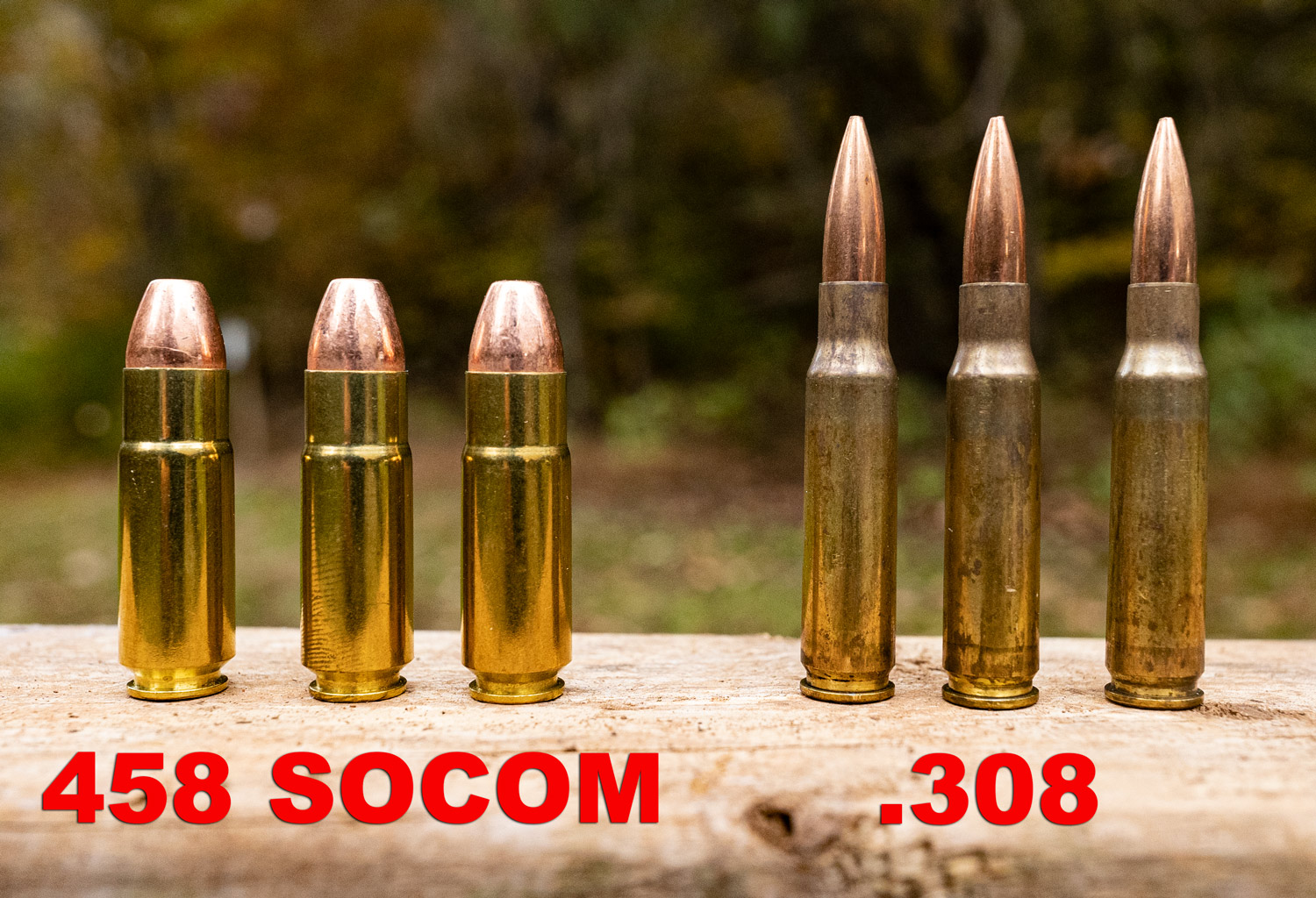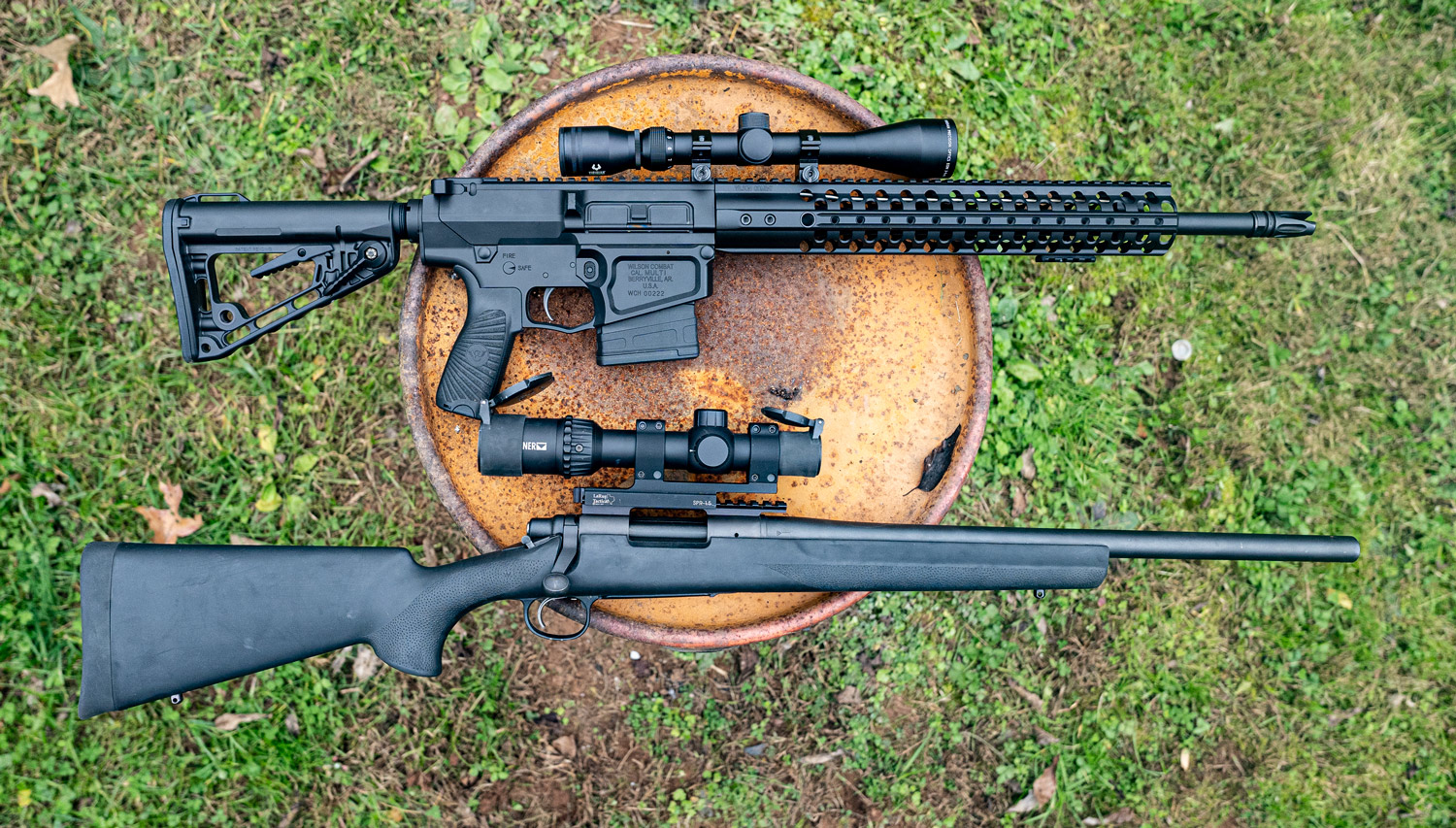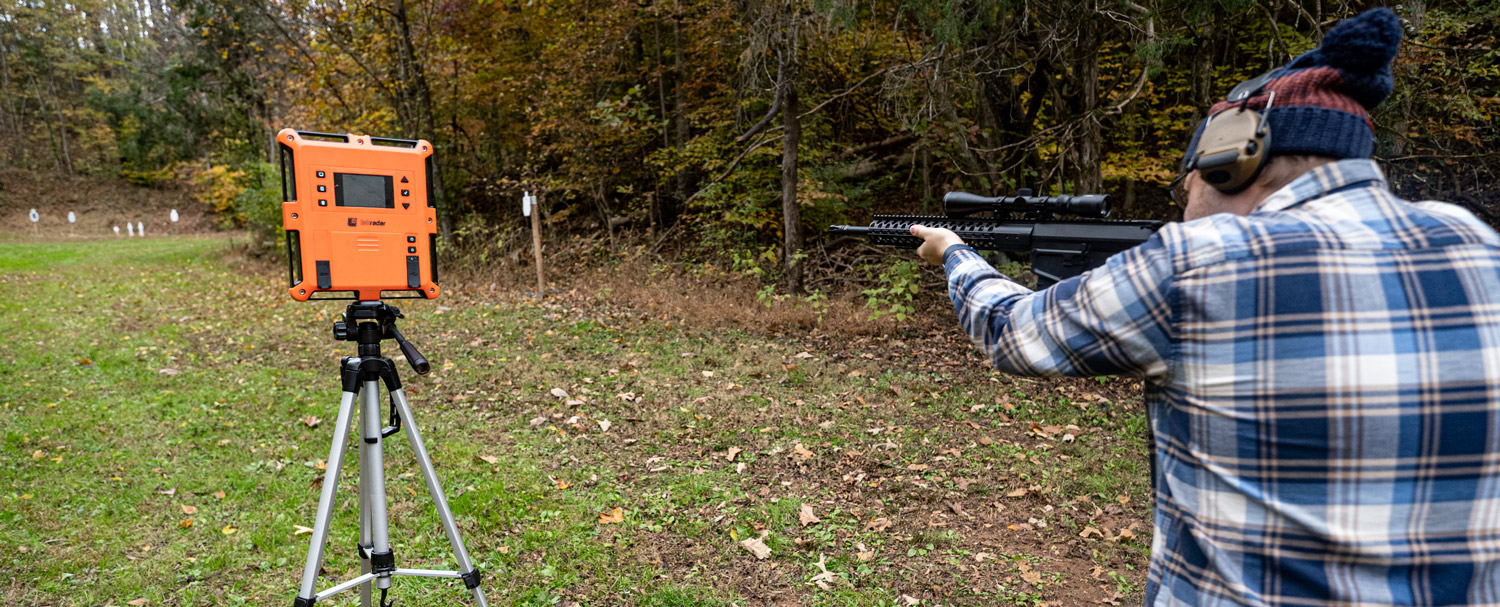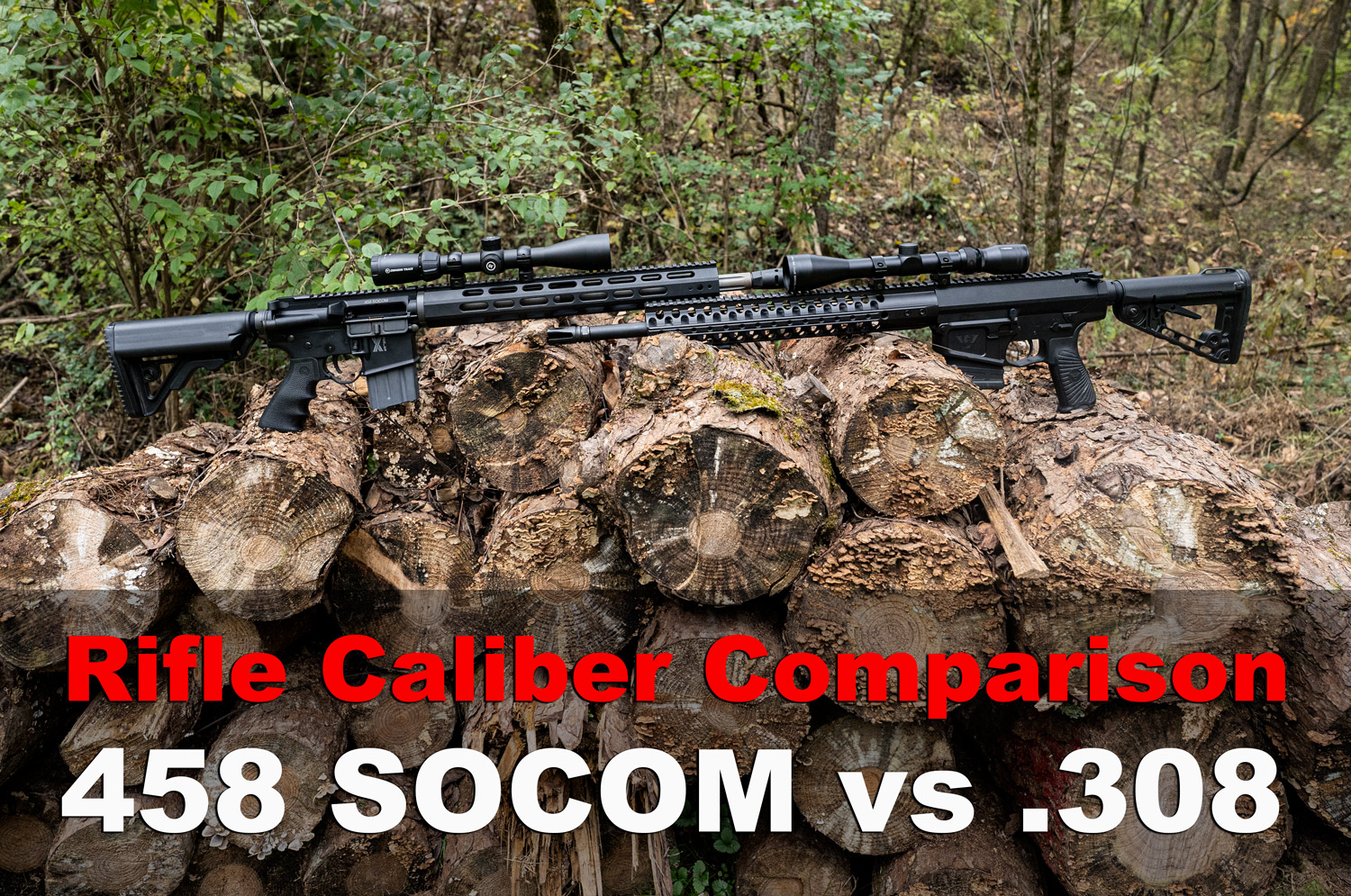A side by side comparison of 458 SOCOM vs 308. What separates these two rifle calibers from each other and is one a better choice for you?
For years, the .308 Winchester has been one of the most trusted cartridges available to gun owners. Since the middle of the 20th century, this round has brought speed, energy, and accuracy to the range and the field.
But with the emergence of modern sporting rifles, the .458 SOCOM has steadily gained in popularity. It has different uses and different goals, and understanding how it compares to the popular .308 Winchester can help you make the right choice for adopting this cartridge.
| .308 Winchester | .458 SOCOM | |
|---|---|---|
| Released | 1952 | 2001 |
| Bullet Diameter | .308 inches | .458 inches |
| Rim Diameter | .4728 inches | .473 inches |
| Case Length | 2.015 inches | 1.575 inches |
| Total Length | 2.8 inches | 2.26 inches |
| Bullet Weight | 125 to 200 grains | 250 to 600 grains |
458 SOCOM vs 308: The Upfront Differences
Size and Shape

When comparing these two cartridges, you can’t help but notice the size differences between the two. The .308 Winchester, while carrying a smaller, narrower bullet, has a longer profile. It’s fairly accurate to say that the .308 Winchester appears long and skinny, while the .458 SOCOM is short and squat, at least compared to the .308.
The Winchester also has a more pronounced neck and shoulders compared to .458 SOCOM ammo. Both have a rim of roughly 0.473 inches, but the .308 Winchester narrows down to fit a bullet measuring .308 inches in diameter, while the SOCOM only narrows down to fit a .458-inch diameter bullet.
The .308 Winchester also has a longer profile from the base to the tip of the bullet. These cartridges measure over two inches in length, while the .458 SOCOM measures just over an inch and a half.
Available Gun Types for .308

For buyers considering these two cartridges, the type of rifle that can fire these rounds is an important consideration. The .458 SOCOM is almost exclusively a cartridge made for AR-style semiautomatic rifles. There are custom-made options that can be ordered through special rifle companies, but you’ll have a hard time finding department stores or outdoor shops that can provide anything but AR-style rifles for the .458 SOCOM.
The .308 Winchester is a different story. This is a widely-used, widely-trusted cartridge that can be chambered in both semiautomatic and bolt-action rifles. If you prefer variety in your firearms, but prefer using the same cartridge across multiple firearms, you may decide that the .308 Winchester is best.
458 SOCOM vs 308: Performance
Velocity
| .308 Winchester | Muzzle Velocity (fps) |
|---|---|
| 110-grain Varmint & Predator (Federal) | 3,300 |
| 150-grain UMC FMJ (Remington) | 2,820 |
| 178-grain BTHP Match (Hornady) | 2,600 |
| 180-grain Power Max Bonded (Winchester) | 2,620 |
| Average | 2,835 |
| .458 SOCOM | Muzzle Velocity (fps) |
| 200-grain ARX (Inceptor) | 2,250 |
| 300-grain Match Solid (Underwood) | 1,840 |
| 325-grain Hornady FTX (SBR) | 1,790 |
| 405-grain Hunting (Buffalo Bore) | 1,675 |
| Average | 1,889 |
Both of these cartridges can be considered fast-flying rounds. Although not at the highest levels of speed, at least not for today’s high-velocity options, neither of these rounds is a tortoise. That said, he .308 Winchester, with a comparable propellant load and lighter bullets, is generally the faster round.
The .308 Winchester, as our small data sample shows above, has a wide range of velocities, usually staying in the scope of 2,600 to 2,900 feet-per-second (fps). However, when loaded with light bullets, such as the 110-grain Varmint & Predator round from Federal, it can reach 3,300 fps. Among all the .308 products we looked at, the round had an average velocity of 2,835 fps, which is a highly respectable speed for any cartridge.

The .458 SOCOM simply can’t keep up. The fastest round in our data (2,250 fps) is almost 400 fps slower than the slowest .308 Winchester. There is no overlap is speeds; in fact there is a gap. The average velocity was just shy of 1,900 fps, over 800 fps slower than the average .308 Winchester.
The goal for the .458 SOCOM was never speed. Yes, it has decent speed, but the overall goal for this round was to provide powerful tactical performance in automatic weapons, particularly those used by elite special forces. Heavy bullets with strong energy from a compact semiautomatic weapon was the goal, not blazing speed or long-range accuracy. So the .458 SOCOM will concede the velocity comparison to the faster .308 Winchester.
Winner: .308 Winchester
458 SOCOM vs. 308: Energy
| .308 Winchester | Muzzle Energy (ft-lbs) |
|---|---|
| 110-grain Varmint & Predator (Federal) | 2,660 |
| 150-grain UMC FMJ (Remington) | 2,648 |
| 178-grain BTHP Match (Hornady) | 2,672 |
| 180-grain Power Max Bonded (Winchester) | 2,743 |
| Average | 2,681 |
| .458 SOCOM | Muzzle Energy (ft-lbs) |
| 200-grain ARX (Inceptor) | 2,248 |
| 300-grain Match Solid (Underwood) | 2,255 |
| 325-grain Hornady FTX (SBR) | 2,313 |
| 405-grain Hunting (Buffalo Bore) | 2,523 |
| Average | 2,335 |
If you are using the cartridge for target shooting, energy is not a massive concern. As long as the bullet reaches its desired destination, it has basically done its job. But for hunting purposes, the energy of a rifle cartridge is an important concern. (It still matters for target shooting, just not as much.)
Once again, we see the .308 Winchester has stronger performance, despite the fact that lighter projectiles often strike with less energy. In this case, it appears the velocity of the .308 Winchester allows the lighter bullets to strike with enhanced energy.
The energy stats for the .308 Winchester all fell in a fairly tight window. (Firearms enthusiasts might call this good grouping!) The stats fell between 2,648 and 2,743 foot-pounds (ft-lbs), and had an average velocity of roughly 2,681.
The .458 SOCOM, however, was a little less powerful, with energies ranging from 2,248 to over 2,500. The average muzzle energy was 2,335 ft-lbs, over 300 ft-lbs less than the .308 Winchester’s average.
Trajectory
The trajectory and long-range accuracy of the .308 Winchester can be hard to compare to the .458 SOCOM, largely because the few manufacturers of the SOCOM rarely provide this information. However, it can be reasonably assumed that the .308 Winchester will have greater long-distance potential than the .458 SOCOM. It has a reputation for reliable medium to long-range performance, while the .458 SOCOM is meant for short-range high-volume target shooting and short- to medium-range hunting.
Head to this .308 Ballistics post for more details about specific 308 load ballistics.
Why Choose the .458 SOCOM?
So why choose the 458 SOCOM at all? It has slower speeds, less energy, and a shorter effective range than the .308 Winchester. One reason is the high bullet weights in subsonic rounds. The .458 SOCOM has subsonic cartridges that pack bullets as heavy as 500 grains, which makes them ideal for suppression firing. Hunting with reduced sound, while still delivering excellent energies to the target, is a common reason to choose the 458 SOCOM vs 308.
It also gives you the chance to simply swap out an upper receiver on your AR-style weapon and use the cartridge. For most AR owners, you don’t have to purchase a whole new weapon to adopt the .458 SOCOM.
Affordable .308 Winchester and .458 SOCOM Rounds
No matter which round is right for you, you’ll find affordable cartridges from our website. You can find all of our in-stock .308 ammo for sale by clicking here. It’s priced right and ready to ship!

